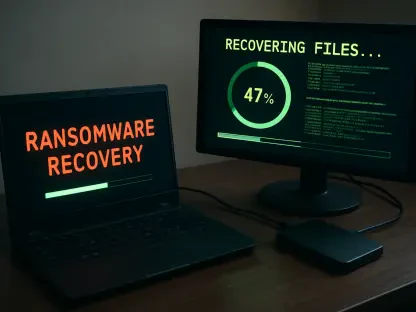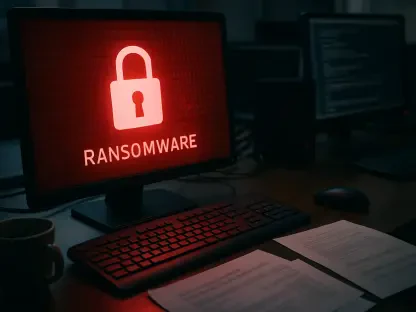Setting the Stage for Cybersecurity Challenges
In an era where digital systems underpin nearly every aspect of global commerce, a single cyberattack can bring entire industries to a standstill, especially in the logistics sector which serves as the backbone of e-commerce and retail. This sector has become a prime target for ransomware, a malicious software that locks critical data until a ransom is paid. This growing threat has exposed vulnerabilities in interconnected supply chains, where a breach in one company can ripple across multiple businesses and disrupt consumer access to goods. The recent attack on Askul, a major Japanese logistics provider, exemplifies this danger, leaving retailers like Muji stranded and highlighting the urgent need for robust cybersecurity solutions in logistics technology.
The stakes are higher than ever as logistics firms manage vast networks of data, from inventory tracking to delivery schedules, all of which are increasingly digitized. A disruption in these systems doesn’t just affect internal operations; it impacts customers, partners, and entire markets. This review delves into ransomware as a critical technology challenge in logistics, examining its mechanisms, real-world impacts, and the defensive tools and strategies needed to safeguard this vital industry.
Understanding Ransomware Technology in Logistics
Mechanisms and Sophistication of Attacks
Ransomware operates by encrypting a victim’s data, rendering systems unusable until a decryption key is provided, often in exchange for payment. In logistics, where real-time data access is essential for coordinating shipments and managing inventory, such attacks are particularly devastating. Cybercriminals exploit vulnerabilities in software, phishing emails, or unsecured networks to infiltrate systems, often using advanced tactics to evade detection. The attack on Askul demonstrated how quickly ransomware can paralyze operations, halting order processing, shipments, and customer support services across a wide network.
Beyond encryption, modern ransomware often includes double-extortion tactics, where attackers steal sensitive data before locking systems and threaten to leak it if demands are unmet. This adds another layer of pressure on logistics firms, which handle vast amounts of customer and business information. The technology behind these attacks continues to evolve, with perpetrators leveraging artificial intelligence to identify weak points and automate breaches, making prevention an ongoing battle for IT teams in the sector.
Performance Impact on Logistics Systems
When ransomware strikes, the performance of logistics systems plummets, as seen in the Askul incident where core functions like new user registrations and returns processing were completely disabled. For a sector reliant on speed and reliability, such downtime translates to canceled orders, delayed deliveries, and frustrated customers. Retailers like Muji, dependent on Askul’s infrastructure, faced a complete halt in online sales and subscription services, with error messages replacing the seamless shopping experience the brand is known for.
The cascading effects extend beyond immediate operational failures. Other businesses tied to Askul, such as Loft and Sogo & Seibu, also reported suspended online sales, illustrating how interconnected systems amplify the impact of a single breach. Economically, these disruptions lead to lost revenue, while reputationally, they erode trust among consumers and partners who expect consistent service from established brands.
Real-World Implications and Case Analysis
Disruption Across Supply Chains
The Askul ransomware attack serves as a stark case study of how cybersecurity failures in logistics can disrupt entire supply chains. With operations nearly paralyzed, pending deliveries were canceled, and businesses reliant on the company’s fulfillment services were left scrambling to mitigate losses. This incident underscores a critical flaw in logistics technology: the lack of robust failover systems to maintain operations during a breach, a gap that cybercriminals are quick to exploit.
For consumers, the impact is tangible, as access to goods and services vanishes overnight. Retailers face not only financial setbacks but also the challenge of rebuilding customer confidence after such public failures. The broader economic consequences are significant, with delays in logistics affecting market dynamics and potentially increasing costs for end users as companies recover from these setbacks.
Rising Threats in Japan’s Corporate Landscape
Japan’s corporate sector, including logistics and manufacturing giants, has seen a troubling rise in ransomware incidents. A notable example is the attack on Asahi, the nation’s largest brewer, by the Qilin gang, which disrupted production schedules and delayed product launches. This pattern reveals a systemic vulnerability in critical infrastructure, where supply chain dependencies create multiple entry points for attackers to exploit.
The increasing frequency of these attacks signals a need for heightened vigilance and investment in cybersecurity across industries. Logistics firms, in particular, must address the unique risks posed by their expansive digital networks, which connect suppliers, retailers, and customers in real time. Without proactive measures, the threat of ransomware will continue to loom large over Japan’s business environment.
Evaluating Defensive Technologies and Strategies
Current Tools and Limitations
Cybersecurity solutions in logistics currently include firewalls, antivirus software, and intrusion detection systems, but these often fall short against sophisticated ransomware. Many companies lack comprehensive backup systems or incident response plans tailored to their operational scale, leaving them vulnerable to prolonged downtime. The Askul breach highlighted this gap, as the company struggled to restore services while investigating potential data leaks.
Moreover, the human factor remains a weak link, with employees often inadvertently facilitating attacks through phishing scams or poor password practices. Training programs exist, but their adoption varies widely across the industry, and smaller logistics firms may lack the resources to implement them effectively. This inconsistency in preparedness exacerbates the risk of widespread disruption from a single point of failure.
Emerging Solutions and Industry Collaboration
Looking ahead, technologies like blockchain for secure data sharing and AI-driven threat detection offer promising avenues for bolstering defenses in logistics. These tools can help identify anomalies in system behavior before an attack escalates, while decentralized data storage reduces the risk of total system lockdowns. Additionally, system redundancies and regular stress testing can ensure continuity even during a breach, minimizing operational impact.
Collaboration between industry stakeholders and government bodies is also critical. Initiatives to share threat intelligence and establish cybersecurity standards can help logistics firms stay ahead of evolving risks. In Japan, where digital infrastructure is integral to economic stability, such partnerships could drive the development of tailored solutions for protecting supply chains from ransomware.
Final Thoughts on Cybersecurity in Logistics
Reflecting on the ransomware attack that crippled Askul and impacted Muji, it becomes clear that the logistics sector stands at a critical juncture in combating cyber threats. The incident exposed deep vulnerabilities in digital infrastructure, where a single breach reverberated across multiple businesses and eroded consumer trust. It served as a wake-up call for the industry to prioritize cybersecurity as a core component of operational strategy.
Moving forward, logistics companies need to invest in advanced defensive technologies, from AI-based monitoring to secure backup systems, to prevent future disruptions. Equally important is the push for comprehensive employee training to address human error as a common entry point for attackers. Industry-wide cooperation, supported by government policies, offers a pathway to standardize protections and build resilience against ransomware.
Ultimately, the road ahead demands a proactive stance, with firms encouraged to view cybersecurity not as a cost but as a safeguard for their future. Regular audits, updated protocols, and a commitment to innovation in threat prevention are essential steps to ensure that logistics networks remain robust and reliable in an increasingly hostile digital landscape.









